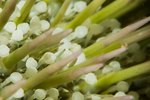
Manila clams (Venerupis philippinarum) are wee bivalve mollusks commonly used in meal preparations, notably for soups, sauces and pastas. They're appreciated for their smooth textures and sweet flavoring. Although Manila clams are visually reminiscent of littleneck clams, they are markedly longer than the latter. The strong resemblance paved the way for one of their oft-used monikers -- Japanese littleneck clams.
Meet the Manila Clam
Identifying Manila clams usually is a pretty easy task. Their shells feature dark markings and are capable of closing entirely. Said shells also feature elements of a couple different colors, namely yellow or dark purple. Filter-feeding is their eating style. Spawning takes place during the summertime. They establish burrows but usually ones that don't have too much depth. Manila clams are members of taxonomic family Veneridae.
National Origins
Manila clams do not hail from the United States -- their existence in the nation is actually nothing more than pure error. These clams originated in Japan, although their name might instead give the impression that their homeland is the Philippines, since Manila is one of the southeastern Asian island nation's best-known cities.
Accidental Visitors
These exotic clams first arrived on North American soil via ships during the 1930s. Some Manila clams accompanied shipments of oyster seeds straight from Japan. The specimens from the ships rapidly and easily adapted to their new environments, where they thrive to this day. Manila clams are seen as far south as the northern portion of California. They're also seen as far north as the province of British Columbia in Canada.
Clam Geography
Manila clams aren't restricted to just Japan and North America. Many Manila clams were brought to France for purposes of aquaculture during the 1960s. They were thought to develop more rapidly than the clams that already existed in France, which were grooved carpet shells (Ruditapes decussatus). In France, they were raised in Atlantic and Mediterranean settings alike. Other European locales for Manila clams include Spain, Germany, Italy and Ireland. They have been in Ireland since at least 1982. Outside of Europe, these clams were also brought to Tahiti.
Modern Day Presence
Manila clams of the United States frequently live out in nature within their adopted North American living environments, often beaches that consist of lots of stones or lots of sand. Although many of these small mollusks roam freely in natural habitats, many of them are also farmed.
References
- Washington Department of Fish & Wildlife: Manila Clams
- University of Portsmouth Biological Sciences: Manila Clam
- The Ecology of Poole Harbour; V.J. May and John Humphreys
- Nonnative Oysters in the Chesapeake Bay: National Research Council of the National Academies
- Tom Douglas' Seattle Kitchen; Tom Douglas
- Marine and Freshwater Products Handbook; Roy E. Martin, Emily Paine Carter and George J. Flick, Jr.
- Aquaculture Production Systems: James H. Tidwell
Photo Credits
-
Photos.com/PhotoObjects.net/Getty Images



